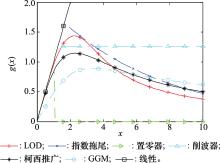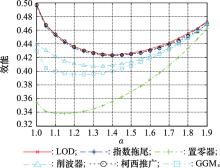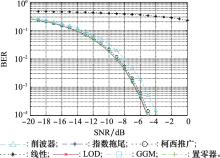Systems Engineering and Electronics ›› 2021, Vol. 43 ›› Issue (7): 1971-1980.doi: 10.12305/j.issn.1001-506X.2021.07.29
• Communications and Networks • Previous Articles Next Articles
Review of nonlinear transformation design for impulsive noise
Zhongtao LUO*, Renming GUO, Yanmei ZHAN
- School of Communication and Information Engineering, Chongqing University of Posts and Telecommunications, Chongqing 400065, China
-
Received:2020-06-01Online:2021-06-30Published:2021-07-08 -
Contact:Zhongtao LUO
CLC Number:
Cite this article
Zhongtao LUO, Renming GUO, Yanmei ZHAN. Review of nonlinear transformation design for impulsive noise[J]. Systems Engineering and Electronics, 2021, 43(7): 1971-1980.
share this article
| 1 | YABUUCHI Y, UMEHARA D, MORIKURA M, et al. Low rate and high reliable modulation schemes for in-vehicle power line communications[C]//Proc.of the IEEE International Symposium on Power Line Communications and its Applications, 2011: 249-254. |
| 2 |
GALLI S , SCAGLIONE A , WANG Z F . For the grid and through the grid: the role of power line communications in the smart grid[J]. Proceedings of the IEEE, 2011, 99 (6): 998- 1027.
doi: 10.1109/JPROC.2011.2109670 |
| 3 |
LIU W Q , SIGLE M , DOSTERT K . Channel characterization and system verification for narrowband power line communication in smart grid applications[J]. IEEE Communications Magazine, 2011, 49 (12): 28- 35.
doi: 10.1109/MCOM.2011.6094003 |
| 4 | 蒋宇中. 超低频非高斯噪声模型及应用[M]. 北京: 国防工业出版社, 2014. |
| JIANG Y Z . Non-Gaussian noise model of extremely low frequency channel and its application[M]. Beijing: National Defense Industry Press, 2014. | |
| 5 |
赵鹏, 蒋宇中, 翟琦, 等. 基于局部方差中值滤波的极/超低频信道噪声抑制方法[J]. 电子学报, 2019, 47 (4): 955- 961.
doi: 10.3969/j.issn.0372-2112.2019.04.023 |
|
ZHAO P , JIANG Y Z , ZHAI Q , et al. Channel noise suppression method based on median filtering using local variance for extreme/super low frequency communications[J]. Acta Electronica Sinica, 2019, 47 (4): 955- 961.
doi: 10.3969/j.issn.0372-2112.2019.04.023 |
|
| 6 |
WENG B W , BARNER K E . Nonlinear system identification in impulsive environments[J]. IEEE Trans.on Signal Processing, 2005, 53 (7): 2588- 2594.
doi: 10.1109/TSP.2005.849213 |
| 7 |
PENG S Y , CHEN B D , SUN L , et al. Constrained maximum correntropy adaptive filtering[J]. Signal Processing, 2017, 140, 116- 126.
doi: 10.1016/j.sigpro.2017.05.009 |
| 8 |
LU L , ZHAO H Q , CHAMPAGNE B . Distributed nonlinear system identification in alpha-stable noise[J]. IEEE Signal Processing Letters, 2018, 25 (7): 979- 983.
doi: 10.1109/LSP.2018.2835763 |
| 9 | KAY S M . Fundamentals of statistical signal processing, volume Ⅱ: detection theory[M]. Englewood Cliffs, NJ: Prentice Hall, 1998: 626- 645. |
| 10 |
SPAULDING A , MIDDLETON D . Optimum reception in an impulsive interference environment-Parts Ⅰ: coherent detection[J]. IEEE Trans.on Communications, 1977, 25 (9): 910- 923.
doi: 10.1109/TCOM.1977.1093943 |
| 11 | NIKIAS C L , SHAO M . Signal processing with Alpha stable distribution and applications[M]. New York: John Wiley and Sons, 1995: 67- 73. |
| 12 | 邱天爽, 张旭秀, 李小兵, 等. 统计信号处理: 非高斯信号处理及其应用[M]. 北京: 中国水利水电出版社, 2004: 165- 166. |
| QIU T S , ZHANG X X , LI X B , et al. Statistical signal processing: non-Gaussian signal processing and its application[M]. Beijing: China Water and Power Press, 2004: 165- 166. | |
| 13 | MIDDLETON D . Statistical-physical models of electromagnetic interference[J]. IEEE Trans.on Electromagnetic Compatibilit, 1977, 19 (3): 106- 127. |
| 14 |
MIDDLETON D . Non-Gaussian noise models in signal processing for telecommunications: new methods an results for Class A and Class B noise models[J]. IEEE Trans.on Information Theory, 1999, 45 (4): 1129- 1149.
doi: 10.1109/18.761256 |
| 15 |
ALSUSA E , RABIE K M . Dynamic peak-based threshold estimation method for mitigating impulsive noise in power-line communication systems[J]. IEEE Trans.on Power Delivery, 2013, 28 (4): 2201- 2208.
doi: 10.1109/TPWRD.2013.2272766 |
| 16 | SWAMI A. Non-Gaussian mixture models for detection and estimation in heavy-tailed noise[C]//Proc.of the IEEE International Conference on Acoustics, Speech, and Signal Processing, 2000: 3802-3805. |
| 17 |
LI X T , SUN J , JIN L W , et al. Bi-parameter CGM model for approximation of α-stable PDF[J]. Electronics Letters, 2008, 44 (18): 1096- 1097.
doi: 10.1049/el:20080955 |
| 18 | ZABIN S M , WRIGHT G A . Nonparametric density estimation and detection in impulsive interference channels. Ⅰ. estimators[J]. IEEE Trans.on Communications, 1994, 42 (234): 1684- 1697. |
| 19 | KADRI A. Suboptimal receivers for weak M-ary chirp signals in non-Gaussian noise[C]//Proc.of the 20th European Wireless Conference, 2014. |
| 20 | KASSAM S A , THOMAS J B . Signal detection in non-Gaussian noise[M]. New York: Springer, 1988. |
| 21 | ROŽIC' N , BANELLI P , BEGUŠIC' D , et al. Multiple-threshold estimators for impulsive noise suppression in multicarrier communications[J]. IEEE Trans.on Signal Processing, 2019, 66 (6): 1619- 1633. |
| 22 |
ZHIDKOV S V . Performance analysis and optimization of OFDM receiver with blanking nonlinearity in impulsive noise environment[J]. IEEE Trans.on Vehicular Technology, 2006, 55 (1): 234- 242.
doi: 10.1109/TVT.2005.858191 |
| 23 |
RABIE K M , ADEBISI B , TONELLO A M , et al. For more energy-efficient dual-hop DF relaying power line communication systems[J]. IEEE Systems Journal, 2018, 12 (2): 2005- 2016.
doi: 10.1109/JSYST.2016.2639321 |
| 24 |
MATHUR A , BHATNAGAR M R , PANIGRAHI B K . Performance evaluation of PLC under the combined effect of background and impulsive noises[J]. IEEE Communications Letters, 2015, 19 (7): 1117- 1120.
doi: 10.1109/LCOMM.2015.2429129 |
| 25 | 蒋宇中. 超低频信道噪声统计特性及应用[D]. 武汉: 华中科技大学, 2008. |
| JIANG Y Z. Noise statistical characteristics of extremely low frequency channel and its application[D]. Wuhan: Huazhong University of Science and Technology, 2008. | |
| 26 | 罗忠涛, 卢鹏, 张杨勇, 等. 大气噪声幅度分布与抑制处理分析[J]. 系统工程与电子技术, 2018, 40 (7): 1443- 1448. |
| LUO Z T , LU P , ZHANG Y Y , et al. Analysis on amplitude distribution and suppression techniques of atmospheric noise[J]. Systems Engineering and Electronics, 2018, 40 (7): 1443- 1448. | |
| 27 | 张杨勇, 刘勇. 低频段大气噪声及处理技术[J]. 舰船科学技术, 2008, 30 (S1): 85- 88. |
| ZHANG Y Y , LIU Y . Atmospheric-noise at low frequency and its processing technique[J]. Ship Science and Technology, 2008, 30 (S1): 85- 88. | |
| 28 |
VASTOLA K . Threshold detection in narrow-band non-Gaussian noise[J]. IEEE Trans.on Communications, 1984, 32 (2): 134- 139.
doi: 10.1109/TCOM.1984.1096037 |
| 29 | 罗忠涛, 卢鹏, 张杨勇, 等. 抑制脉冲型噪声的限幅器自适应设计[J]. 电子与信息学报, 2019, 41 (5): 1160- 1166. |
| LUO Z T , LU P , ZHANG Y Y , et al. Adaptive design of limi-ters for impulsive noise suppression[J]. Journal of Electronics and Information Technology, 2019, 41 (5): 1160- 1166. | |
| 30 |
ZHIDKOV S V . Analysis and comparison of several simple impulsive noise mitigation schemes for OFDM receivers[J]. IEEE Trans.on Communications, 2008, 56 (1): 5- 9.
doi: 10.1109/TCOMM.2008.050391 |
| 31 | KIMURA S, NAKAMURA T, SAITO M, et al. PAR reduction for OFDM signals based on deep clipping[C]//Proc.of the 3rd International Symposium on Communications, Control and Signal Processing, 2008: 911-916. |
| 32 |
JUWONO F H , GUO Q H , HUANG D F , et al. Deep clipping for impulsive noise mitigation in OFDM-based power-line communications[J]. IEEE Trans.on Power Delivery, 2014, 29 (3): 1335- 1343.
doi: 10.1109/TPWRD.2013.2294858 |
| 33 |
SWAMI A , SADLER B M . On some detection and estimation problems in heavy-tailed noise[J]. Signal Processing, 2002, 82 (12): 1829- 1846.
doi: 10.1016/S0165-1684(02)00314-6 |
| 34 | LI X T, JIANG Y Q, LIU M. A near optimum detection in alpha-stable impulsive noise[C]//Proc.of the IEEE International Conference on Acoustics, Speech and Signal Processing, 2009: 3305-3308. |
| 35 |
LI X T , SUN J , WANG S Y , et al. Near-optimal detection with constant false alarm ratio in varying impulsive interference[J]. IET Signal Processing, 2013, 7 (9): 824- 832.
doi: 10.1049/iet-spr.2013.0024 |
| 36 |
ZOZOR S , BROSSIER J M , AMBLARD P O . A parametric approach to suboptimal signal detection in α-stable noise[J]. IEEE Trans.on Signal Processing, 2006, 54 (12): 4497- 4509.
doi: 10.1109/TSP.2006.882066 |
| 37 |
DAI Z , WANG P B , CAO W H . Design and performance analysis of parametric suboptimal detectors in SαS noise[J]. IET Communications, 2020, 14 (7): 1169- 1174.
doi: 10.1049/iet-com.2019.0606 |
| 38 |
代振, 王平波, 卫红凯. 非高斯背景下基于Sigmoid函数的信号检测[J]. 电子与信息学报, 2019, 41 (12): 2945- 2950.
doi: 10.11999/JEIT190012 |
|
DAI Z , WANG P B , WEI H K . Signal detection based on sigmoid function in non-Gaussian noise[J]. Journal of Electronics and Information Technology, 2019, 41 (12): 2945- 2950.
doi: 10.11999/JEIT190012 |
|
| 39 | 罗忠涛, 詹燕梅, 郭人铭, 等. 脉冲噪声中基于指数函数的可变拖尾非线性变换设计[J]. 电子与信息学报, 2020, 42 (4): 932- 940. |
| LUO Z T , ZHAN Y M , GUO R M , et al. Variable tailing nonlinear transformation design based on exponential function in impulsive noise[J]. Journal of Electronics and Information Technology, 2020, 42 (4): 932- 940. | |
| 40 |
LUO Z T , JONCKHEERE E A . Nonlinearity design with power-law tails for correlation detection in impulsive noise[J]. IEEE Access, 2020, 8, 40667- 40679.
doi: 10.1109/ACCESS.2020.2976499 |
| 41 |
张杨勇, 罗忠涛, 聂雅琴, 等. 抑制脉冲型噪声的高斯拖尾非线性函数设计[J]. 电子学报, 2019, 47 (11): 2407- 2412.
doi: 10.3969/j.issn.0372-2112.2019.11.024 |
|
ZHANG Y Y , LUO Z T , NIE Y Q , et al. Optimal design of the Gaussian-tailed zero memory nonlinearity function for impulsive noise suppression[J]. Acta Electronica Sinica, 2019, 47 (11): 2407- 2412.
doi: 10.3969/j.issn.0372-2112.2019.11.024 |
|
| 42 |
SAAIFAN K A , HENKEL W . Decision boundary evaluation of optimum and suboptimum detectors in Class-A interference[J]. IEEE Trans.on Communications, 2013, 61 (1): 197- 205.
doi: 10.1109/TCOMM.2012.100812.110565 |
| 43 | OH H , NAM H . Design and performance analysis of nonlinearity preprocessors in an impulsive noise environment[J]. IEEE Trans.on Vehicular Technology, 2017, 66 (1): 364- 376. |
| 44 | 王平波, 蔡志明. 非高斯数据的高斯化滤波[J]. 声学与电子工程, 2006, 83 (3): 26- 30. |
| WANG P B , CAI Z M . Gaussian filtering of non-Gaussian data[J]. Acoustics and Electronics Engineering, 2006, 83 (3): 26- 30. | |
| 45 |
LI X T , CHEN P , FAN L S , et al. Normalisation-based receiver using BCGM approximation for α-stable noise channels[J]. Electronics Letters, 2013, 49 (15): 965- 967.
doi: 10.1049/el.2013.1289 |
| 46 |
李旭杰, 赵鸿燕, 杨成胡. α稳定噪声中基于正态变换的次优接收机[J]. 电路与系统学报, 2012, 17 (3): 94- 97.
doi: 10.3969/j.issn.1007-0249.2012.03.018 |
|
LI X J , ZHAO H Y , YANG C H . Normalized transform based sub-optimal receiver in α-stable impulsive environment[J]. Journal of Circuit and Systems, 2012, 17 (3): 94- 97.
doi: 10.3969/j.issn.1007-0249.2012.03.018 |
|
| 47 | 罗忠涛, 卢鹏, 张杨勇, 等. 基于高斯化-广义匹配的脉冲型噪声处理方法研究[J]. 电子与信息学报, 2018, 40 (12): 2928- 2935. |
| LUO Z T , LU P , ZHANG Y Y , et al. A novel method for nonlinear processing in impulsive noise based on Gaussianization and generalized matching[J]. Journal of Electronics and Information Technology, 2018, 40 (12): 2928- 2935. | |
| 48 |
NDO G , SIOHAN P , HAMON M . Adaptive noise mitigation in impulsive environment: application to power-line communications[J]. IEEE Trans.on Power Delivery, 2010, 25 (2): 647- 656.
doi: 10.1109/TPWRD.2009.2035505 |
| 49 |
代振, 王平波, 卫红凯. 非高斯背景下的自适应限幅检测研究[J]. 电子学报, 2020, 48 (3): 426- 430.
doi: 10.3969/j.issn.0372-2112.2020.03.002 |
|
DAI Z , WANG P B , WEI H K . Adaptive limiter detection in non-Gaussian noise background[J]. Acta Electronica Sinica, 2020, 48 (3): 426- 430.
doi: 10.3969/j.issn.0372-2112.2020.03.002 |
|
| 50 |
RABIE K M , ALSUSA E . Preprocessing-based impulsive noise reduction for power-line communications[J]. IEEE Trans.on Power Delivery, 2014, 29 (4): 1648- 1658.
doi: 10.1109/TPWRD.2013.2291513 |
| 51 |
RABIE K M , ALSUSA E . On improving communication robustness in PLC systems for more reliable smart grid applications[J]. IEEE Trans.on Smart Grid, 2015, 6 (6): 2746- 2756.
doi: 10.1109/TSG.2015.2430528 |
| 52 |
IKPEHAI A , ADEBISI B , RABIE K M . Energy-efficient vector OFDM PLC systems with dynamic peak-based threshold estimation[J]. IEEE Access, 2017, 5, 10723- 10733.
doi: 10.1109/ACCESS.2017.2709254 |
| 53 |
OH H , NAM H , PARK S . Adaptive threshold blanker in an impulsive noise environment[J]. IEEE Trans.on Electromagnetic Compatibility, 2014, 56 (5): 1045- 1052.
doi: 10.1109/TEMC.2014.2311853 |
| 54 |
ZHANG G Y , WANG J , YANG G S , et al. Nonlinear processing for correlation detection in symmetric alpha-stable noise[J]. IEEE Signal Processing Letters, 2018, 25 (1): 120- 124.
doi: 10.1109/LSP.2017.2776317 |
| 55 |
POWELL M J D . An efficient method for finding the minimum of a function of several variables without calculating derivatives[J]. Computer Journal, 1964, 7 (2): 155- 162.
doi: 10.1093/comjnl/7.2.155 |
| 56 |
NELDER J A , MEAD R . A simplex method for function minimization[J]. Computer Journal, 1965, 7 (4): 308- 313.
doi: 10.1093/comjnl/7.4.308 |
| 57 | WRIGHT M H. Direct search methods: once scorned, now respectable[C]//Proc.of the Dundee Biennial Conference in Numerical Analysis, 1996: 191-208. |
| 58 |
ZABIN S M , POOR H V . Parameter estimation for Middleton Class A interference processes[J]. IEEE Trans.on Communications, 1989, 37 (10): 1042- 1051.
doi: 10.1109/26.41159 |
| 59 |
SAMIUDDIN M , EL-SAYYAD G M . On nonparametric kernel density estimates[J]. Biometrika, 1990, 77 (4): 865- 874.
doi: 10.1093/biomet/77.4.865 |
| 60 | SILVERMAN B W . Density estimation for statistics and data analysis[M]. London: Chapman and Hall, 1986: 45- 48. |
| 61 | 邱天爽. 相关熵与循环相关熵信号处理研究进展[J]. 电子与信息学报, 2020, 42 (1): 105- 118. |
| QIU T S . Development in signal processing based on correntropy and cyclic correntropy[J]. Journal of Electronics and Information Technology, 2020, 42 (1): 105- 118. |
| [1] | Tianye SUN, Wei SUN, Jianjun WU. UAV formation rapid assembly method based on improved Quatre algorithm [J]. Systems Engineering and Electronics, 2022, 44(9): 2840-2848. |
| [2] | Jing YU, Enmi YONG, Hanyang CHEN, Dong HAO, Xiancai ZHANG. Bi-level mission planning method for multi-cooperative UAV air-to-ground attack [J]. Systems Engineering and Electronics, 2022, 44(9): 2849-2857. |
| [3] | Yong ZHANG, Changjiu LI, Xichao SU, Rongwei CUI. Maintenance task scheduling of carrier-based aircraft fleet in hangar based on HTLBO algorithm [J]. Systems Engineering and Electronics, 2022, 44(9): 2858-2868. |
| [4] | Jianfeng YANG, Heye XIAO, Liang LI, Junqiang BAI, Weihao DONG. Multi-level module partition method of UAV based on fuzzy clustering and expert scoring mechanism [J]. Systems Engineering and Electronics, 2022, 44(8): 2530-2539. |
| [5] | Junlong LI, Songzhou LI, Di ZHOU. Optimization method for three-impulse rendezvous under multi-constraints [J]. Systems Engineering and Electronics, 2022, 44(8): 2612-2620. |
| [6] | Lu ZHUANG, Zhong LU, Haijing SONG, Jia ZHOU. An optimization method for development assurance level assignment of airborne system [J]. Systems Engineering and Electronics, 2022, 44(8): 2688-2698. |
| [7] | Shiying YAN, Kefei YAN, Wei FANG, Hengyang LU. Large-scale multi-objective algorithm based on neighborhood adaptive of differential evolution [J]. Systems Engineering and Electronics, 2022, 44(7): 2112-2124. |
| [8] | Qian LIU, Yunjun LU, Kebin CHEN, Mengyao HAN, Liang GUO. Combat task decomposition EVA method based on binary constraints of task subject [J]. Systems Engineering and Electronics, 2022, 44(7): 2201-2210. |
| [9] | Andi TANG, Tong HAN, Dengwu XU, Huan ZHOU, lei XIE. An improved salp swarm algorithm using Gaussian distribution estimation strategy [J]. Systems Engineering and Electronics, 2022, 44(7): 2229-2240. |
| [10] | Haoran SHI, Faxing LU, Jiangxin QI, Guang YANG. Cooperative target tracking of UAVs based on aided beacon [J]. Systems Engineering and Electronics, 2022, 44(7): 2302-2310. |
| [11] | Lingyu MENG, Bingli GUO, Wen YANG, Xinwei ZHANG, Zuoqing ZHAO, Shanguo HUANG. Network routing optimization approach based on deep reinforcement learning [J]. Systems Engineering and Electronics, 2022, 44(7): 2311-2318. |
| [12] | Minghui GAI, Su ZHANG, Weitian SUN, Yude NI, Lei YANG. Structural-feature enhancement of SAR targets based on complex value compatible total variation [J]. Systems Engineering and Electronics, 2022, 44(6): 1862-1872. |
| [13] | Jiang JIANG, Qiancheng JIN, Xueming XU, Shuai HOU, Jichao LI. Preliminary study on national defense science and technology system engineering in the era of intelligence [J]. Systems Engineering and Electronics, 2022, 44(6): 1880-1888. |
| [14] | Jianlei ZHAO, Haiyang LI. Maneuvering identification method of non-cooperative aircraft based onsparse orbit information [J]. Systems Engineering and Electronics, 2022, 44(6): 1950-1956. |
| [15] | Jiawei ZHANG, Fengchen QIAN, Junqiang YANG, Qian ZHAO, Zhengrong ZHANG. Survey on routing and spectrum allocation algorithm in elastic optical networks [J]. Systems Engineering and Electronics, 2022, 44(6): 2001-2010. |
| Viewed | ||||||
|
Full text |
|
|||||
|
Abstract |
|
|||||





